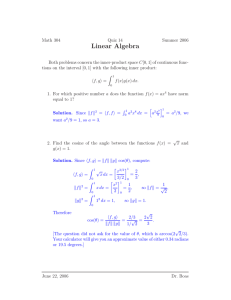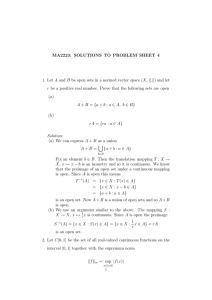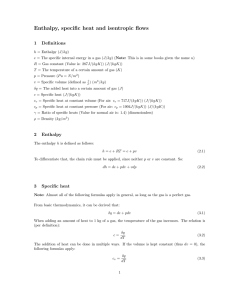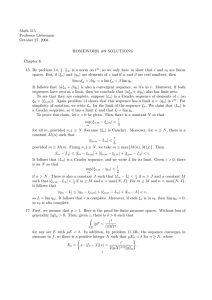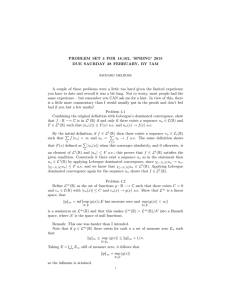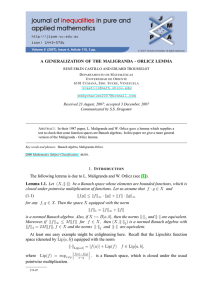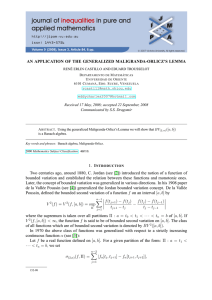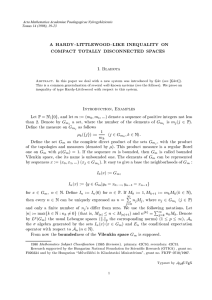Acta Mathematica Academiae Paedagogicae Ny´ıregyh´aziensis 24 (2008), 215–220 www.emis.de/journals ISSN 1786-0091
advertisement
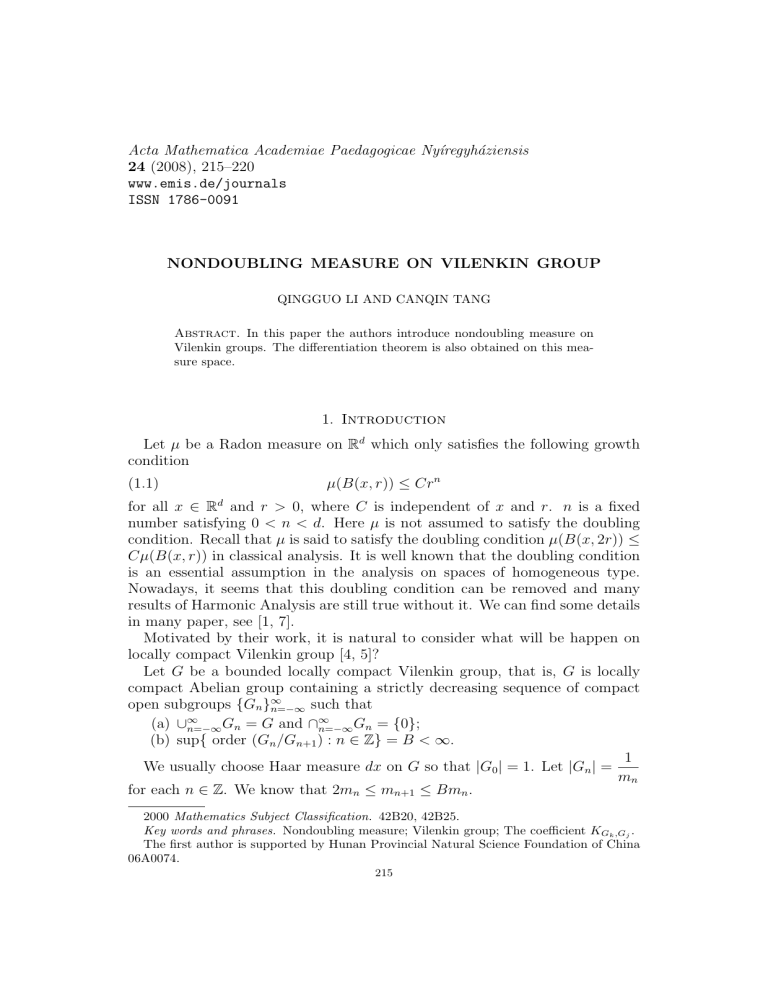
Acta Mathematica Academiae Paedagogicae Nyı́regyháziensis
24 (2008), 215–220
www.emis.de/journals
ISSN 1786-0091
NONDOUBLING MEASURE ON VILENKIN GROUP
QINGGUO LI AND CANQIN TANG
Abstract. In this paper the authors introduce nondoubling measure on
Vilenkin groups. The differentiation theorem is also obtained on this measure space.
1. Introduction
Let µ be a Radon measure on Rd which only satisfies the following growth
condition
(1.1)
µ(B(x, r)) ≤ Crn
for all x ∈ Rd and r > 0, where C is independent of x and r. n is a fixed
number satisfying 0 < n < d. Here µ is not assumed to satisfy the doubling
condition. Recall that µ is said to satisfy the doubling condition µ(B(x, 2r)) ≤
Cµ(B(x, r)) in classical analysis. It is well known that the doubling condition
is an essential assumption in the analysis on spaces of homogeneous type.
Nowadays, it seems that this doubling condition can be removed and many
results of Harmonic Analysis are still true without it. We can find some details
in many paper, see [1, 7].
Motivated by their work, it is natural to consider what will be happen on
locally compact Vilenkin group [4, 5]?
Let G be a bounded locally compact Vilenkin group, that is, G is locally
compact Abelian group containing a strictly decreasing sequence of compact
open subgroups {Gn }∞
n=−∞ such that
∞
(a) ∪n=−∞ Gn = G and ∩∞
n=−∞ Gn = {0};
(b) sup{ order (Gn /Gn+1 ) : n ∈ Z} = B < ∞.
1
We usually choose Haar measure dx on G so that |G0 | = 1. Let |Gn | =
mn
for each n ∈ Z. We know that 2mn ≤ mn+1 ≤ Bmn .
2000 Mathematics Subject Classification. 42B20, 42B25.
Key words and phrases. Nondoubling measure; Vilenkin group; The coefficient KGk ,Gj .
The first author is supported by Hunan Provincial Natural Science Foundation of China
06A0074.
215
216
QINGGUO LI AND CANQIN TANG
Now, if we choose another Radon measure µ on G, and it is not satisfied
the doubling condition, that is, there does not exist a constant C, such that
µ(Gn ) ≤ Cµ(Gn+1 ) or µ(Gn+1 ) ≤ Cµ(Gn ). Then what will be happen on G?
It is our main question to answer in this paper.
2. Main results and proofs
Firstly, we need to make out the connection of nondoubling measure µ and
Lebesgue measure ν on R.
Lemma 1. Nondoubling measure µ is absolute continuous to Lebesgue measure ν.
Proof. Let E = ∪∞
n=1 En , En is open set and ν(E) = 0, then
0 ≤ µ(E) =
µ(∪∞
n=1 En )
≤C
∞
X
µ(En ) ≤ Cν(E) = 0.
n=1
This implies µ(E) = 0. That is, µ ¿ ν.
¤
Therefore, by Radon-Nikodym
R Theorem,
R there exists a negative measurable
function f , such that µ(A) = A f dν = A f dx.
Similar to this condition on µ on R, suppose that a negative Radon measure
µ on Vilenkin group G is absolute continuous to its Haar measure dx, and µ
no longer satisfied the doubled condition, but satisfying the following growth
condition: µ(Gk ) ≤ C0 |Gk |.
In [7], X. Tolsa defined the coefficients KQ,R to characterize the closeness of
two cubes Q and R in Rn . We will consider the same question on Vilenkin
groups.
Definition 1. The coefficient KGk ,Gj measures how close Gk is to Gj , in some
sense. Given two sets Gk ⊂ Gj , (k ≥ j) in G. Set
KGk ,Gj = 1 +
k−j
X
µ(Gk−i )
i=1
|Gk−i |
,
where |Gk−i | denotes Gk−i ’s Haar measure.
In the following lemmas we will show some of the properties of the coefficients
KGk ,Gj .
Lemma 2. If Gk ⊂ Gj ⊂ Gν , then KGk ,Gj ≤ KGk ,Gν , KGj ,Gν ≤ CKGk ,Gν and
KGk ,Gν ≤ KGk ,Gj + KGj ,Gν .
Proof. Let Gk ⊂ Gj ⊂ Gν , then k > j > ν and k − j < k − ν
KGk ,Gj = 1 +
k−j
X
µ(Gk−i )
i=1
|Gk−i |
≤1+
k−ν
X
µ(Gk−i )
i=1
|Gk−i |
= KGk ,Gν
NONDOUBLING MEASURE ON VILENKIN GROUP
217
and
KGj ,Gν = 1 +
j−ν
X
µ(Gj−k )
k=1
|Gj−k |
i−ν
X
=1+
k0 =1+i−j
=1+
j−ν
X
µ(Gj−k−(i−j) )
k=1
|Gi−k−(i−j) |
µ(Gi−k0 )
|Gi−k0 |
i−ν
X
µ(Gi−k0 )
≤1+
|Gi−k0 |
k0 =1
= KGi ,Gν ,
where k 0 = k + i − j and i − j < i − ν.
Furthermore, we have
KGi ,Gν = 1 +
i−ν
X
µ(Gi−k )
k=1
= KGi ,Gj +
|Gi−k |
=1+
i−j
X
µ(Gi−k )
k=1
|Gi−k |
+
i−k
X
µ(Gi−k )
|Gi−k |
k=i−j+1
µ(Gj−1 ) µ(Gj−2 )
µ(Gν )
+
+ ··· +
|Gj−1 |
|Gj−2 |
|Gν |
≤ KGi ,Gj + 1 +
j−ν
X
µ(Gj−k )
k=1
|Gj−k |
= KGi ,Gj + KGj ,Gν .
¤
We say that Gk ⊂ Gk−1 is (B, β)-doubling if µ(Gk−1 ) ≤ βµ(Gk ).
Lemma 3. If N is some positive integer and the cubes Gk−1 , Gk−2 , . . . , Gk−N
are non (B, β)-doubling (with β > B), then KGk ,Gk−N ≤ C, with C depending
on β and C0 .
Proof. For β > B, suppose Gk−1 , Gk−2 , . . . , Gk−N are non (B, β)-doubling. We
have µ(Gk−2 ) ≥ βµ(Gk−1 ) and then
µ(Gk−N ) ≥ βµ(Gk−N +1 ) ≥ · · · ≥ β N −i µ(Gk−i ) (∀i = 1, . . . , N − 1).
That is,
µ(Gk−i ) ≤
µ(Gk−N )
β N −i
(∀i = 1, . . . , N − 1)
218
QINGGUO LI AND CANQIN TANG
then
KGk ,Gk−N = 1 +
N
X
µ(Gk−i )
i=1
|Gk−i |
N −1
µ(Gk−N ) X µ(Gk−N )
=1+
+
|Gk−N |
|Gk−i |β N −i
i=1
N −1
µ(Gk−N ) µ(Gk−N ) X |Gk−N | 1
+
|Gk−N |
|Gk−N | i=1 |Gk−i | β N −i
N
−1 µ ¶N −i
X
B
≤ 1 + C0 + C0
β
i=1
µ
¶i
∞
X
B
≤ 1 + C0 + C0
≤ C.
β
i=1
=1+
¤
Lemma 4. If N is some positive integer and for some β < 2,
µ(Gk−N ) ≤ βµ(Gk−N +1 ) ≤ . . . ≤ β N µ(Gk )
then KGk ,Gk−N ≤ C, with C depending on β and C0 .
Proof. For β < 2, we have
KGk ,Gk−N = 1 +
N
X
µ(Gk−i )
i=1
≤1+
|Gk−i |
N
X
β i µ(Gk )
i=1
|Gk−i |
N
µ(Gk ) X β i |Gk |
|Gk | i=1 |Gk−i |
N µ ¶i
X
β
≤ 1 + C0
2
i=1
µ
¶i
∞
X
β
≤ 1 + C0
≤ C.
2
i=1
=1+
¤
Notice that, the properties of Lemma 3 says that if the density of the measure µ grows much faster than the Haar measure of GK , then the coefficients
KGk ,Gk−N , remain bounded while the Lemma 4 says that if the measure grows
too slowly, then they also remain bounded.
NONDOUBLING MEASURE ON VILENKIN GROUP
219
Next theorem is the application of the differentiation theorem. The case on
R can be seen in [2].
n
Theorem 1. Let f ∈ L1loc (µ). If β > B, then for almost every x with respect to µ, there exists a sequence of (B, β)-doubling Gj (x), (x ∈ Gj ) with
limj→∞ |Gj | = 0, such that
Z
1
lim
f (y)dµ(y) = f (x).
j→∞ µ(Gj ) G
j
Proof. We will show that for almost every x with respect to µ there is (B, β)doubling Gj contained x with |Gj | as small as we wish. This fact combined
with the differentiation theorem, completes the proof of the lemma.
We know that for almost every x with respect to µ
µ(Gj )
> 0.
j→∞ |Gj |
lim
(2.1)
Suppose for any x ∈ Gj satisfying (2.1) and assume that none of Gj+k , k ≥ 1,
is (B, β)-doubling. Then, it is easy to see that
µ(Gj ) > βµ(Gj+1 ) > β 2 µ(Gj+2 ) > · · · > β k µ(Gj+k ) (∀k ≥ 1)
and then
β k µ(Gj+k )
µ(Gj ) |Gj |
<
·
.
|Gj+k |
|Gj | |Gj+k |
Therefore,
µ ¶k
µ ¶k
µ(Gj+k )
B
µ(Gj )
B
<
·
≤ C0
.
|Gj+k |
β
|Gj |
β
Note that β > B, the right hand side tends to zero for k → ∞ and this
makes contradiction.
¤
References
[1] J. Garcı́a-Cuerva and A. E. Gatto. Boundedness properties of fractional integral operators associated to non-doubling measures. Studia Math., 162(3):245–261, 2004.
[2] J. Garcı́a-Cuerva and A. E. Gatto. Lipschitz spaces and Calderón-Zygmund operators
associated to non-doubling measures. Publ. Mat., 49(2):285–296, 2005.
[3] J. Garcı́a-Cuerva and J. M. Martell. Weighted inequalities and vector-valued CalderónZygmund operators on non-homogeneous spaces. Publ. Mat., 44(2):613–640, 2000.
[4] G. Gát. Orthonormal systems on Vilenkin groups. Acta Math. Hungar., 58(1-2):193–198,
1991.
[5] G. Gát. Investigations of certain operators with respect to the Vilenkin system. Acta
Math. Hungar., 61(1-2):131–149, 1993.
[6] J. Orobitg and C. Pérez. Ap weights for nondoubling measures in Rn and applications.
Trans. Amer. Math. Soc., 354(5):2013–2033 (electronic), 2002.
[7] X. Tolsa. BMO, H 1 , and Calderón-Zygmund operators for non doubling measures. Math.
Ann., 319(1):89–149, 2001.
220
QINGGUO LI AND CANQIN TANG
Received March 24, 2008.
Qingguo Li,
College of Mathematics and Econometrics,
Hunan University,
Changsha,
China
E-mail address: liqingguoli@yahoo.com.cn
Canqin Tang,
Department of Mathematics,
Dalian Maritime University,
Dalian,
China
E-mail address: tangcq2000@yahoo.com.cn
